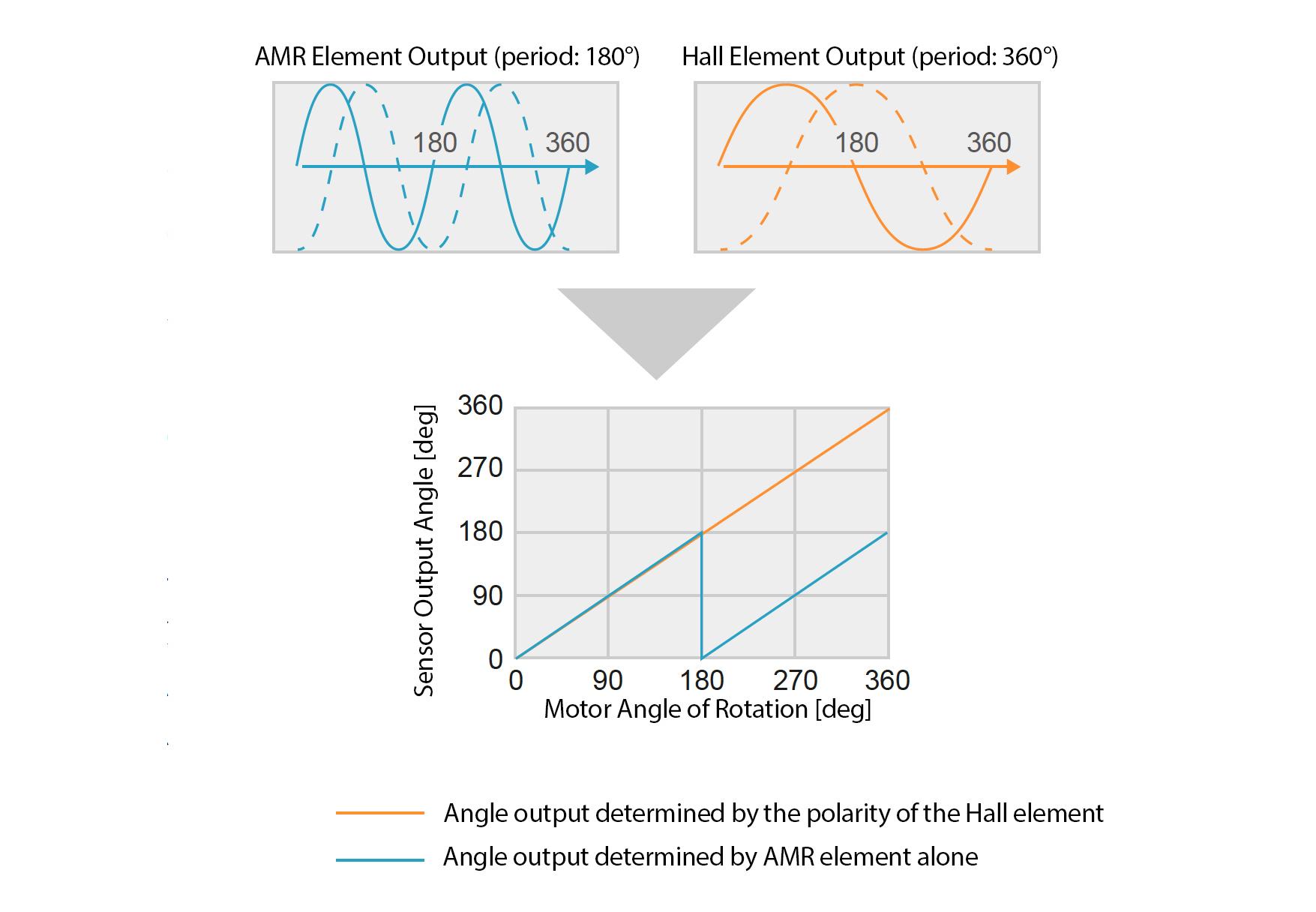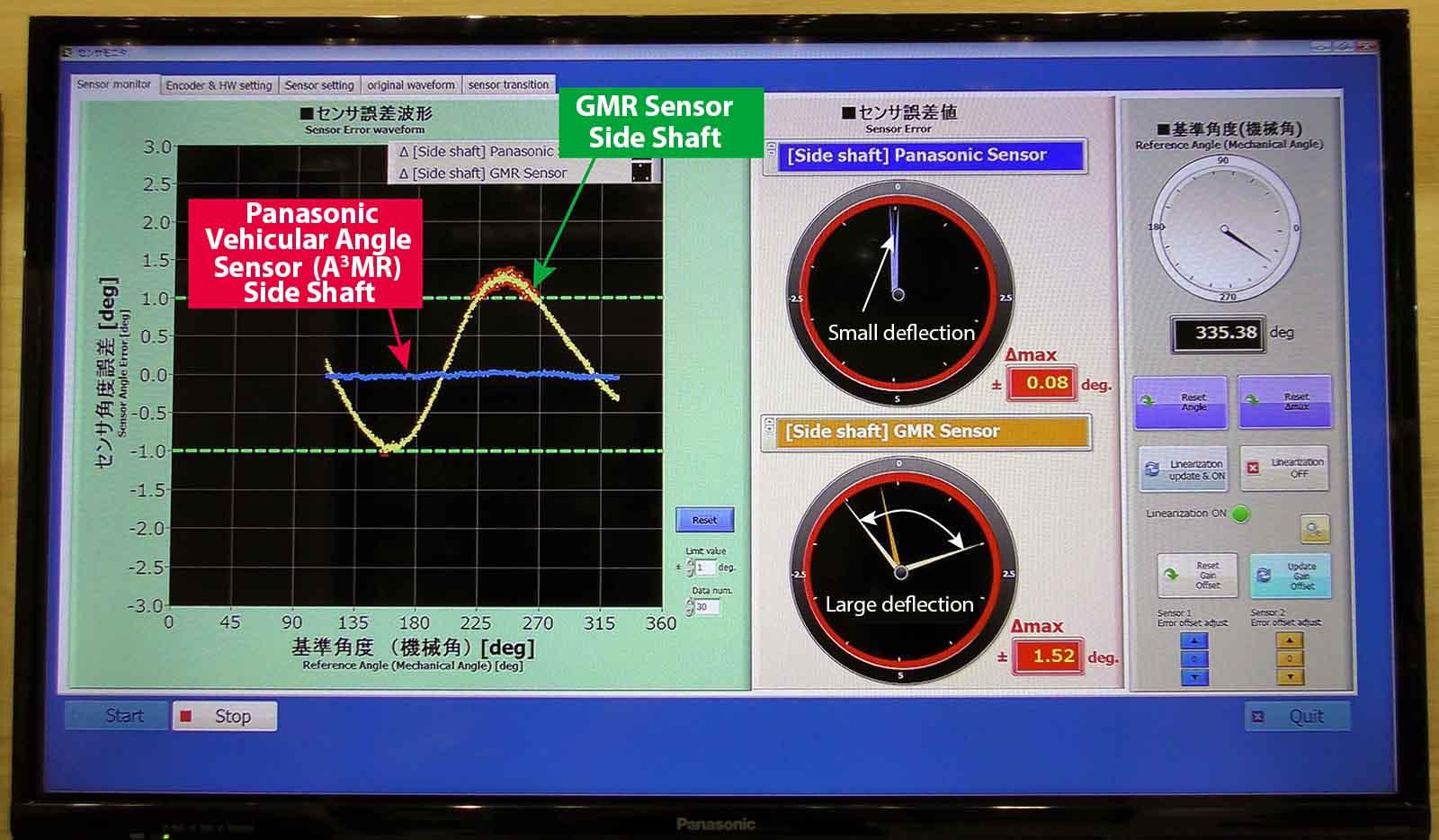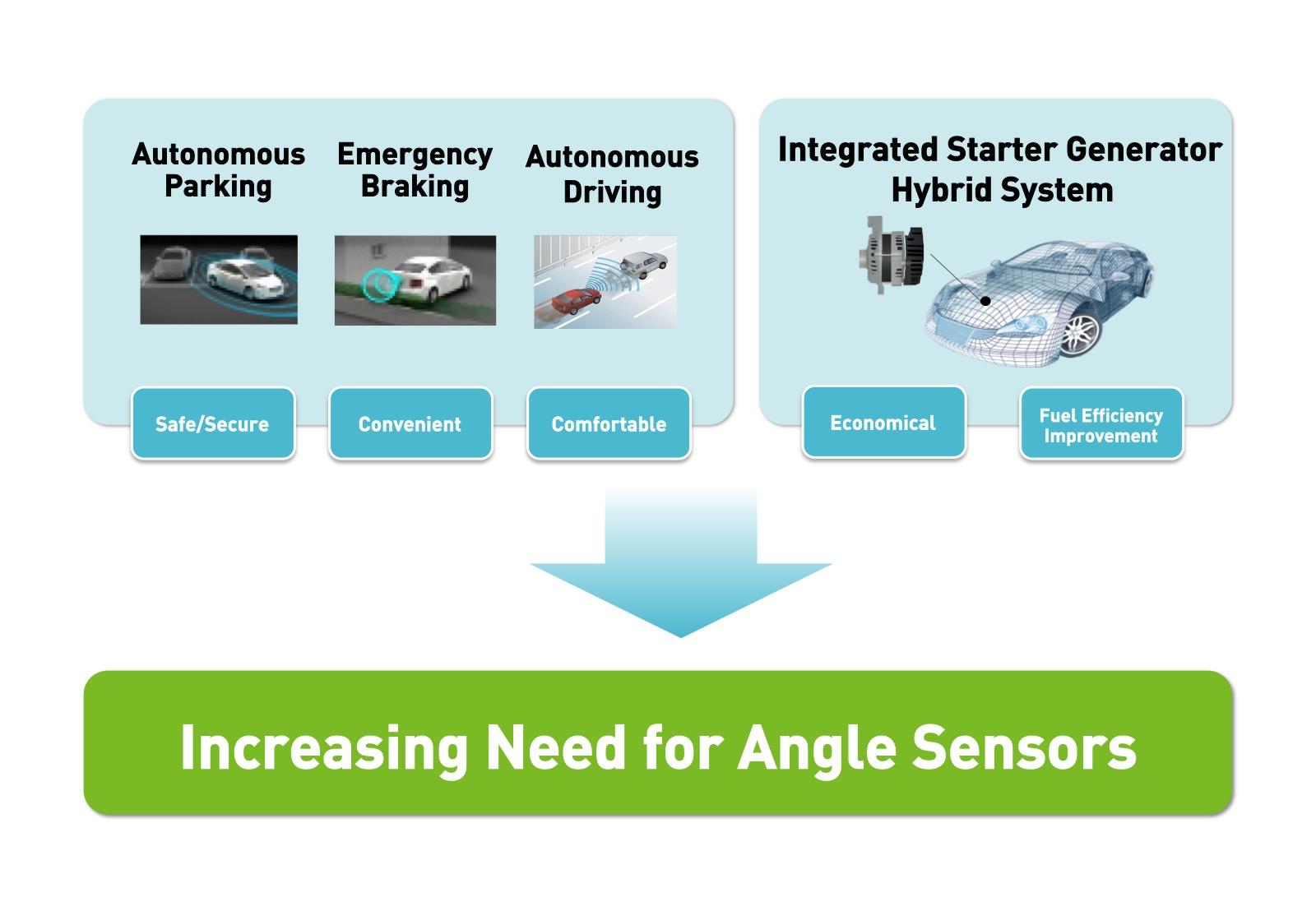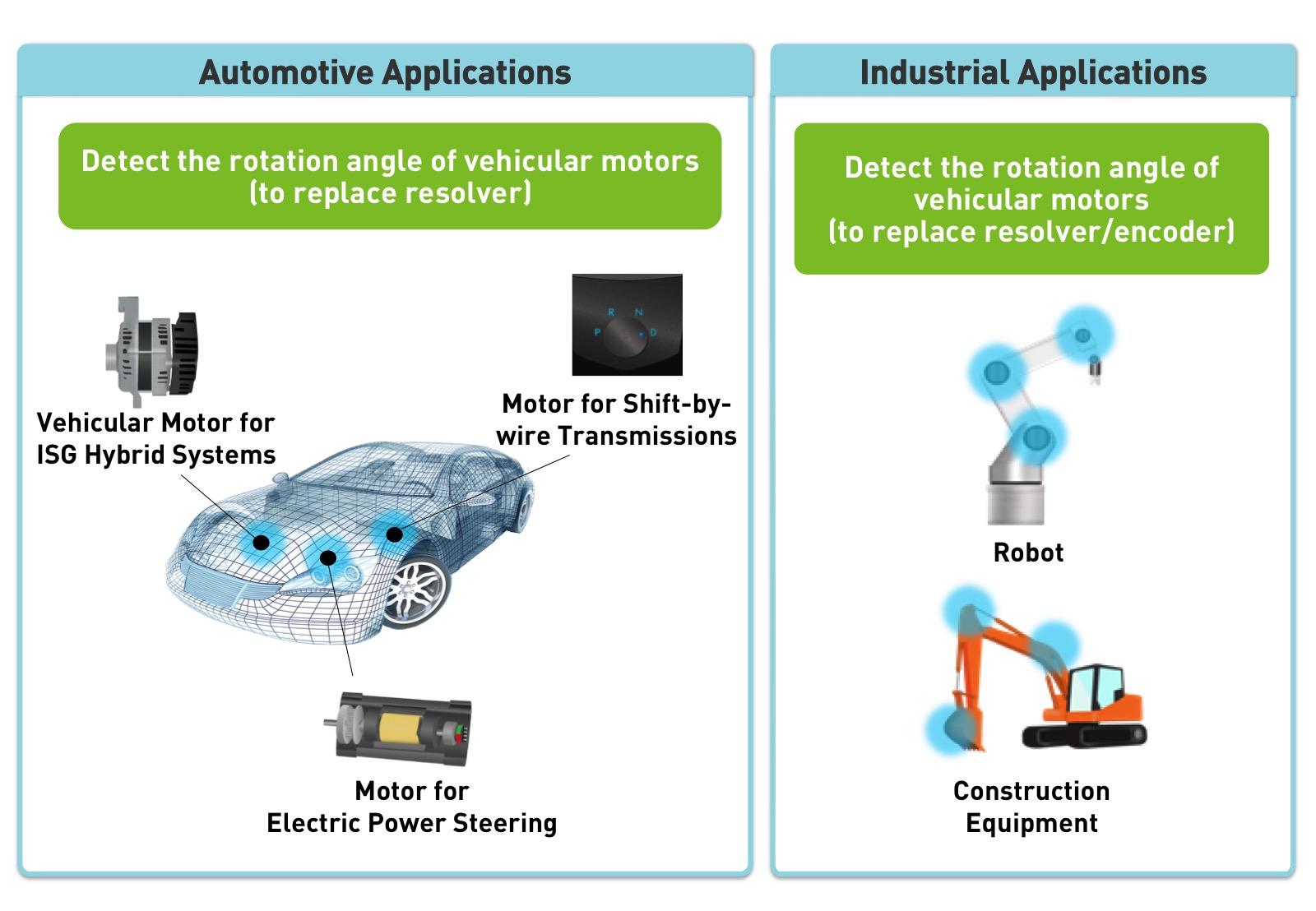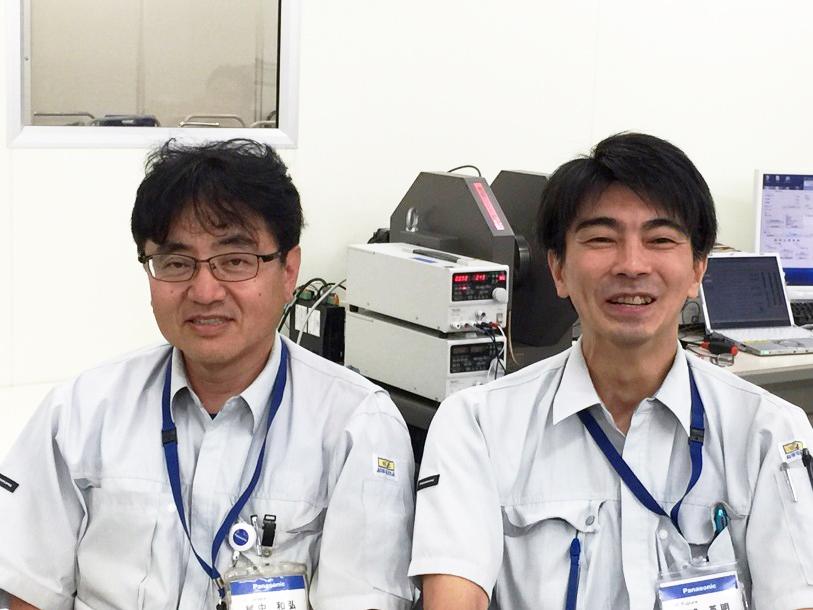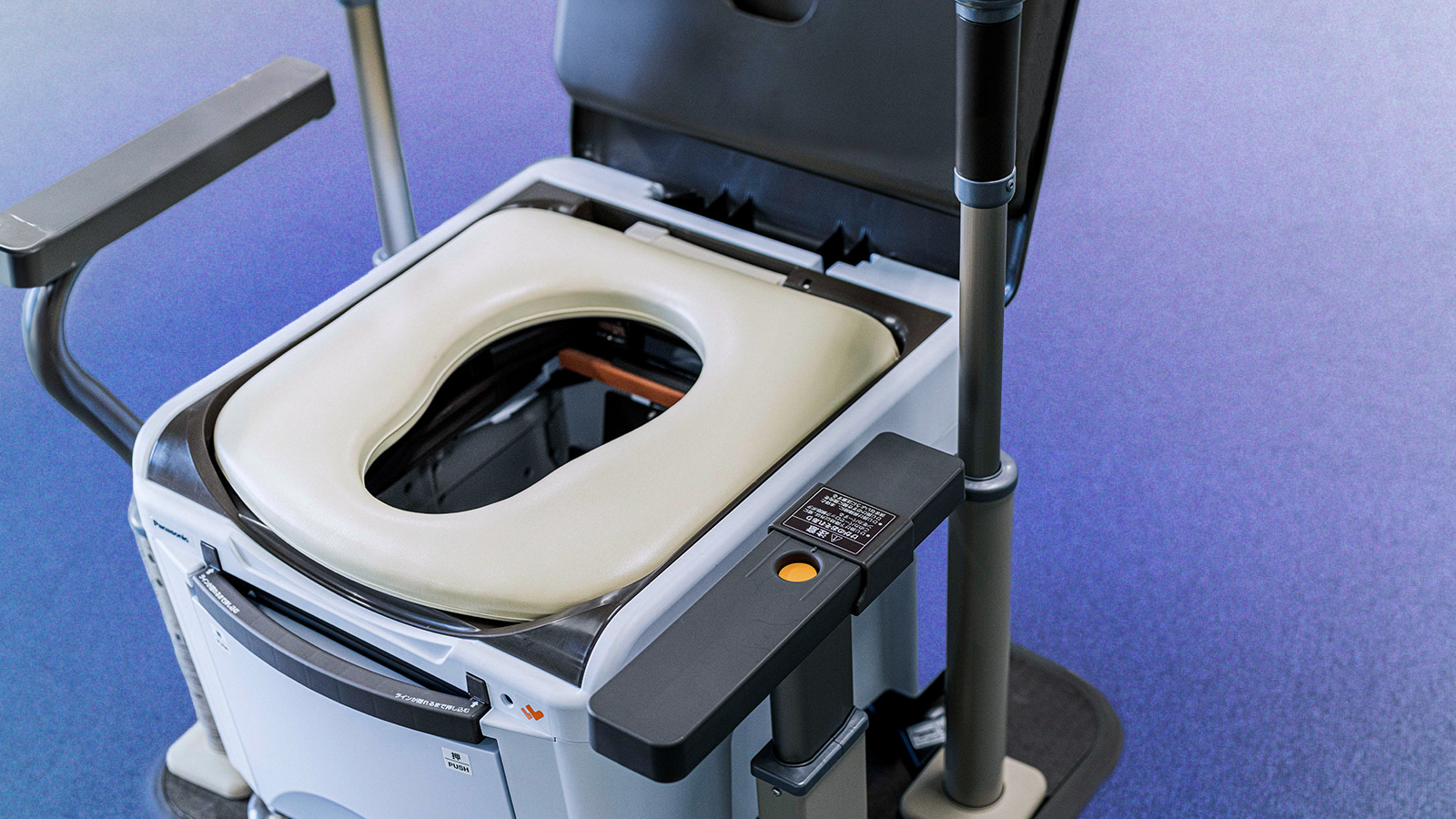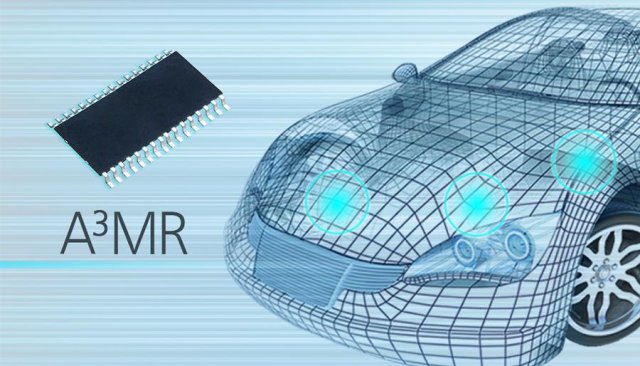
As the electrification of automobiles progresses, autonomous driving and Advanced Driver Assistance Systems (ADAS) are beginning to draw more and more attention. Consequently, there is increasing demand for highly accurate control technology. This article introduces Panasonic's newly developed vehicular angle sensor, the "A3MR."
About the "A3MR" (A-cubed MR)
The "Vehicular High-precision Angle Sensor" or the "A3MR" Panasonic unveiled in March 2017 is a sensor device that detects the rotation angle of vehicular motors with superior precision.
The 3 "A"s of the "A3MR" stands for:
Anisotropic (AMR - Anisotropic Magneto Resistance element)
Absolute (Absolute angle measurement)
Accurate (Accurate detection)
-
"A3MR" is a hybrid system featuring both the AMR and Hall elements to realize:
- Compact, lightweight and high-accuracy detection up to 360°
- Compatibility with strong magnetic fields due to high noise immunity
- High degree of freedom in layout which facilitates design and brings down costs
Sensor characteristics
"A3MR" brings to life both compact size and high-accuracy, which was never before possible. By using magnets, this sensor can precisely detect the number of motor shaft rotations. It performs well even when the magnetic field strength varies, thus it enables exacting control even when the sensor is placed at a distance from the motor shaft with its "Side Shaft Detection." And even in cases where multipolar magnets, which generate large variations in magnetic fields, are used because, for example, the motor has a thick shaft, the sensor is highly immune against noise. The sensor is also resilient against temperature variations.
1. Compact, lightweight and high-accuracy detection up to 360°
The A3MR sensor using the AMR thin film, which detects the angle between the direction of the electric current and the magnetization direction of the free layer, generally measures resistance variation with a period of 180° (GMR and TMR have a period of 360°). The A3MR also combines the Hall element with the integrated circuit, and is embedded with an algorithm that converts the 180°-period in the AMR element to 360° to bring to life a sensor that offers high-accuracy detection of up to 360° using the AMR thin film.
2. Resistance to variations in magnetic field strength
In recent years, the industry is shifting towards vehicle electrification (electric vehicles, hybrid vehicles, etc.) and magnetic fields inside vehicles are beginning to have a stronger impact. As such, there is increasing demand for sensors that exhibit the same level of resistance regardless of the strength of magnetic fields and changes in temperature. The "A3MR" suppresses magnetic disturbance by increasing the strength of the magnetic field of the magnet used for detection. Moreover, since the AMR detects the resistance value of the magneto-resistive film, this sensor can maintain high angle accuracy even in strong magnetic fields. Furthermore, to minimize the impact of temperature changes, Panasonic developed a magneto-resistive film that is less affected by changes in the magnetic field strengths (that easily reaches magnetic saturation), so that its resistance value remains the same even when the temperature changes. Conventional sensors require temperature correction throughout the system to main their angular accuracy over the entire applicable temperature range, but the A3MR maintains high angular accuracy in temperatures below 200℃.
Panasonic's sensing devices
Panasonic develops and manufactures devices that meet various sensing needs such as temperature/humidity, electrical currents, placement, distance, and movement, and sells these devices for automotive/industrial/ICT applications. Below is a summary of the needs going forward of the electrical component industry (in 3 fields: automotive, industry, ICT).
1. Automotive
There are needs in 2 key areas. 'Vehicle Safety,' which includes "preventing skidding," "side impact air bags that will deploy in an overturn," and "autonomous driving." And 'Environment and Comfort,' which refers to, for example, "green vehicles such as EVs/FCVs," and creating a "comfortable, in-vehicle environment." As automotive regulations in Japan, Europe, and North America tighten, we must be well prepared to clear even stricter regulations.
2. Industrial
We forecast that 'single operation or operation per infrastructure' such as "manufacturing robots" and "infrastructure management" will become mainstream. And demand for 'unmanned factories, comfortable living spaces, and infrastructure maintenance' including "autonomous robots that can cruise around the warehouse freely," "integrated energy management for buildings," and "systems that diagnose and warn against infrastructure degradation" is on the rise. More specifically, there is demand for "countermeasures against heat for devices," "high-precision sensing," and "long-term safety guarantee."
3. ICT
We foresee that, in a society where 'mobile devices' such as "smartphones" and "tablets" are commonplace, 'wearable devices' with information/communication capabilities like "smart watches" and "smart glasses" will be utilized more and more. The key themes with respect to wearable devices are "temperature control to prevent low temperature burns even when these devices are worn for an extended period of time," "clearance of electromagnetic wave regulations," "super compact circuit design" etc. and further improvements are needed in these areas.
What application is the "A3MR" angular sensor suited for?
Advanced Driver Assistance System (ADAS) and autonomous driving is evolving, and as such, there is mounting demand for autonomous control of vehicles, from driving to turning to stopping. Especially, with respect to vehicles, both sensor accuracy and excellent safety in demand, and with the Electric Power Steering (EPS) we have realized highly precise control of the vehicle's direction of movement with respect to automatic parking and lane keeping. Moreover, with regards to the Integrated Starter Generator (ISG) motor, which provides assistance when starting the engine, we have reined in rotational irregularities, and thereby improved fuel efficiency.
And in regard to industrial applications, due to the automation of construction and agricultural machinery and the robotization of factories, there is greater demand for both high-precision control and superior safety. The A3MR not only conforms to ISO26262 (functional safety) required of vehicular sensors, it can be utilized with the same design as resolvers, which are currently widest in use, so it can serve as an alternative without any design change. In addition, the A3MR can also be used for shift-by-wire transmission motors and in industrial robots and construction machinery. The business is anticipated to grow to 40 billion yen by 2025.
Panasonic will continue to propose solutions that help customers reduce costs and resources spent on design and development as well as leadtimes by improving the performance and minimizing the size and weight of vehicles and various devices.
Contributing to realizing a safe, secure, comfortable mobility society
"Our customers are currently evaluating the performance of our angular sensor. They have high expectations for not only the performance of our sensors, but also Panasonic's sensing solutions as a whole. We believe that communicating frequently with our users, and understanding their systems and issues in depth are key. There are a number of obstacle before we are able to propose costs and specifications that our users can be satisfied with, but we believe that this sensor will be able to contribute to a safe, secure, comfortable mobility society. We would like to launch the sensor in 2019, and to help it grow to become the No.1 device in the world so that in the future, this will become an essential part of Panasonic's industrial business.
Kazuhiro Onaka and Hideaki Fujiura describes the angular sensor's potential. (Panasonic AIS Company, Device Solutions Business Division)
- Disclaimer:
- We would like to note that Panasonic Newsroom is not a place to address personal Customer Service issues. Even though this is not the forum, Panasonic is always eager to resolve your concerns. Our local customer services contacts can be found at Global Support or you can see our list of Social Media Accounts to find the right channel for your queries and concerns.
Related Links
Related News
- [Press Release] Panasonic Develops a Vehicular High-precision Angle Sensor (Mar 27, 2017)
- Panasonic Showcasing 10 Themes and Has Published 7 Articles at ITS World Congress Melbourne 2016 (Oct 13, 2016)
- ITS World Congress 2016 Panasonic Concept Movie
- Panasonic Presents the Latest Highlights in Automated and Connected Vehicle Technologies and ITS Big Data Solutions (Oct 08, 2015)


